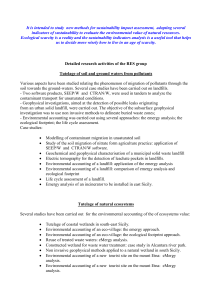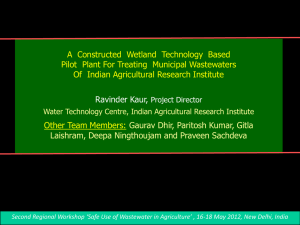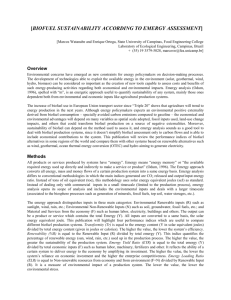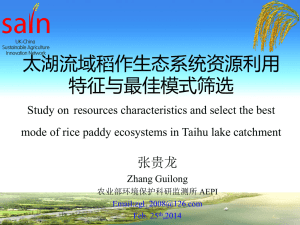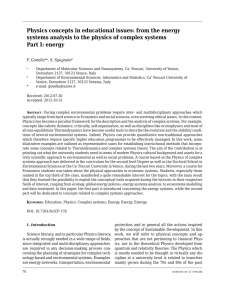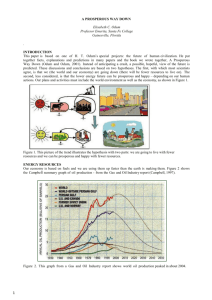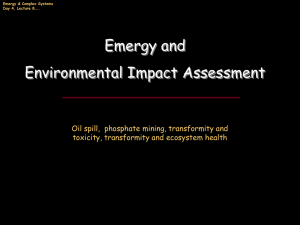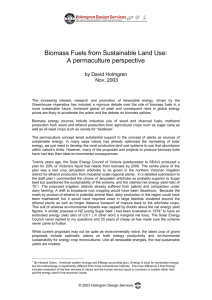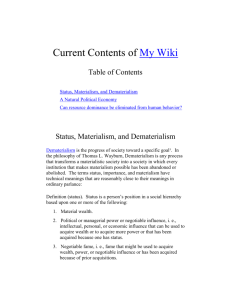April 2000 - Hubbert Peak of Oil Production
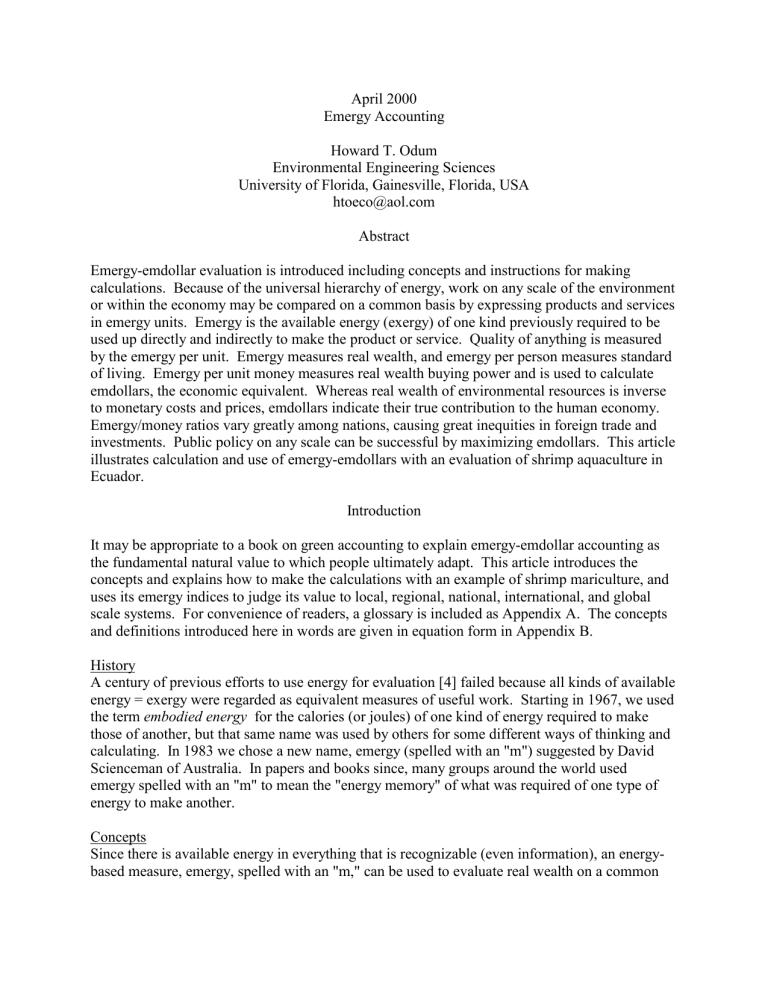
April 2000
Emergy Accounting
Howard T. Odum
Environmental Engineering Sciences
University of Florida, Gainesville, Florida, USA htoeco@aol.com
Abstract
Emergy-emdollar evaluation is introduced including concepts and instructions for making calculations. Because of the universal hierarchy of energy, work on any scale of the environment or within the economy may be compared on a common basis by expressing products and services in emergy units. Emergy is the available energy (exergy) of one kind previously required to be used up directly and indirectly to make the product or service. Quality of anything is measured by the emergy per unit. Emergy measures real wealth, and emergy per person measures standard of living. Emergy per unit money measures real wealth buying power and is used to calculate emdollars, the economic equivalent. Whereas real wealth of environmental resources is inverse to monetary costs and prices, emdollars indicate their true contribution to the human economy.
Emergy/money ratios vary greatly among nations, causing great inequities in foreign trade and investments. Public policy on any scale can be successful by maximizing emdollars. This article illustrates calculation and use of emergy-emdollars with an evaluation of shrimp aquaculture in
Ecuador.
Introduction
It may be appropriate to a book on green accounting to explain emergy-emdollar accounting as the fundamental natural value to which people ultimately adapt. This article introduces the concepts and explains how to make the calculations with an example of shrimp mariculture, and uses its emergy indices to judge its value to local, regional, national, international, and global scale systems. For convenience of readers, a glossary is included as Appendix A. The concepts and definitions introduced here in words are given in equation form in Appendix B.
History
A century of previous efforts to use energy for evaluation [4] failed because all kinds of available energy = exergy were regarded as equivalent measures of useful work. Starting in 1967, we used the term embodied energy for the calories (or joules) of one kind of energy required to make those of another, but that same name was used by others for some different ways of thinking and calculating. In 1983 we chose a new name, emergy (spelled with an "m") suggested by David
Scienceman of Australia. In papers and books since, many groups around the world used emergy spelled with an "m" to mean the "energy memory" of what was required of one type of energy to make another.
Concepts
Since there is available energy in everything that is recognizable (even information), an energybased measure, emergy, spelled with an "m," can be used to evaluate real wealth on a common
basis, but calories of different kinds are not added. Emergy recognizes and measures the universal energy hierarchy, which should be regarded as a 5th energy law.
Systems of nature and humanity on all scales are part of a universal energy hierarchy, which is the network of energy transformation processes which joins small scales to larger scales, and these to even larger scales. We represent everything in systems diagrams from small on the left to larger on the right. Available energy (potential energy = exergy) at one level is used up in each transformation process to generate a smaller amount at the next larger scale. Self organization reinforces designs in which the higher quality energies on the right feed back to the left to reinforce the input process (autocatalytic feedback).
Calories of energy of different kinds are not equivalent in their contribution of useful work.
Directly and indirectly it takes about 1000 kilocalories of sunlight to make a kilocalorie of spatially dispersed organic matter, about 40,000 to make a kilocalorie of coal, about 170,000 kilocalories to make a kilocalorie of electrical power, and 10 million or more to support a typical kilocalorie of human service. The larger the scale, the higher the quality of the energy, but the less there is of it. There is less energy but more emergy per unit in valuable things. The numbers are largest for genetic information.
Thus, the emergy of anything is the available energy (potential energy = exergy) of one kind previously used up to make it. For example, the solar energy previously required is called the solar emergy. To keep from confusing energy that is in a product with that which has been used up to make it, emergy units are called emcalories (or emjoules). The emergy of one kind required to be transformed to make one unit of energy of another is called the transformity. In this article solar insolation emergy is used as the common measure. Solar transformities are used
= solar emergy per unit energy, and the units are solar emjoules per joule. Transformity measures the quality of energy and its position in the universal energy hierarchy.
Since people don't think in emergy units, the economic equivalent called the emdollar is obtained by dividing emergy by the ratio of emergy to money in the economy. Emdollars are the economic equivalent of emergy. Emdollars indicate the money circulation whose buying power is supplied by use of a quantity of emergy. Emdollars are estimated from emergy and vice versa using emergy/money ratios for the economy concerned. The global emergy/money ratio was evaluated as 1.1 x 1012 sej/$ in 2000 [1] with 70% of the whole world's annual real wealth use coming from non-renewable fuels and materials and 30% from the renewable environment (sun, tide, and earth heat).
Uses of Emergy to Select Policies
Emergy can be identified as the correct measure of real wealth, because successful surviving designs in self organization of nature and the economy are those that maximize emergy power
(empower) on every scale. (Maximum empower updates the maximum power principle introduced by Alfred Lotka as the 4th energy law [3]). Humans in the short range may evaluate products and services in other ways, often expressing their choices with market values, but in the longer range and the larger scale of societies and their environment, they are forced by trial and error or by logic to fit their ideas and behavior to maximize empower.
To determine whether something makes a net contribution to the economy, everything can be put in solar emergy units. Then you can correctly compare the yield to the economy with what was required to be purchased from the economy. Fossil fuels, depending on their concentration and price, provide 3-15 times more emergy than the economy uses to get and process them.
Oil from oil shale and photovoltaic electricity have no net emergy contribution. They yield less emergy to the economy than is required in emergy of materials and services to operate them.
Thus, they cannot independently support the economy nor become economical as primary sources.
Emergy evaluates exchanges on a common basis. There are large inequities in real wealth of international trade. Developed nations using raw products of some less developed nations take many times more emergy from those economies than is in the buying power of the money they pay in exchange.
A full explanation of energy hierarchy and emergy evaluation and a summary of that literature is available in a 1996 book [10]. This article is a condensation.
Emergy Evaluation Procedure
A system of interest is selected and main components, inputs, and outputs are identified. An energy systems diagram is drawn with main parts and pathways (example in Figure 1). The dozen symbols suggested for the diagram have been in wide use since 1965 and explained in various books [5, 6, 11]. The boundary selected for the diagram is used to identify all the important input pathways crossing into the chosen system. Each of these inputs becomes a line item in an evaluation table (example in Table 1). If there is a stored quantity within the boundary which is supplying available energy and/or materials faster than it is being restored, it is acting as a non-renewable source and is included as a line item.
Column #1 indicates the footnote where details are given; column #2 is the name of the input.
Column #3 has the rate of flow of the input. For a steady state evaluation, annual values of required inputs from nature and from the human economy are listed in usual units for materials, energy, and money (grams, joules, $, etc.). These include the flows necessary to sustain structural storages and assets. (Initial capital requirements are averaged over the anticipated life of the structure-storage.)
In column #4, emergy per unit (g, J, $, etc.) is inserted from previous studies and the source cited in the footnote for that line item. The input requirements in column 3 are multiplied by the emergy/unit values in column 4 to obtain the emergy flow = empower value (in solar emjoules per year) for column #5.
For inputs where the data are in money units representing services, the money flow, converted according to the currency exchange into international dollars, is multiplied by the emergy/money ratio (sej/$) of the economy from which the human services were contributed.
Annual emdollar flows are calculated in the last column of the evaluation table (column #6 in
Table 1) by dividing by the emergy/money ratio of the economy of the intended audience
(example: 1.0 x 1012 sej/yr 2000 $) to obtain annual emdollars (abbreviated em$) for Column
#6. Emergy/money ratios come from emergy evaluations of whole nations. Some of these have been published [10], and there are summary tables [5, 13, 14]. An interpolation Appendix table in reference [10] evaluates the U.S. emergy/money ratio for different years from the total fuel use and gross economic product.
Table 1
Annual Emergy Flows in Shrimp Pond Mariculture in Ecuador, 1986
53,000 Hectares; 1.5 m deep; see Figure 1
__________________________________________________________
Note Item Raw Units Emergy/unit Solar Emergy Emdollars
J, g, $ sej/unit 1020 sej/yr 106 em$/yr*
__________________________________________________________
Free Environmental Inputs:
1 Sunlight
2 Rain
3 Pumped sea waters
4 Post larvae
1.97 E18 J
2.65 E15 J
7.33 E15 J
3.2 E9 ind.
1
15444
15444
1.04 E11
0.0197
0.41
1.1
3.4
2
41
110
340
493 Sum of items 2-4 -- --
__________________________________________________________
4.92
Purchased Inputs:
5 Labor 1.32 E14 J 2.62 E6 3.79
6
7
8 Phosphorus fertiliz.
9 Feed protein
10 Other services
11 Costs of post-larvae
12 Capital costs
13 Interest paid back in sucre-converted-to $
Fuel
Nitrogen fertilizer
Sum of # 5-13
Sum without feed
2.34 E15 J
1.14 E9 g
2.62 E8 g
3.29 E15 J
3.56 E7 $US
3.56 E7 US$
1.93 E6 $US
11.2 E6 $US
--
--
5.3 E4
4.19 E9
2.0 E10
1.31 E5
8.5 E12
8.7 E12
8.5 E12
8.5 E12
--
--
1.24
0.048
0.053
4.3
3.0
3.0
0.164
0.95
16.9
12.7
__________________________________________________________
Sum of all inputs -- -- 21.82
379
124
5
5
430
300
300
16
95
1,654
1,224
2,147
1,717 Sum without feed -- -- 17.6
__________________________________________________________
Output Products:
14 Shrimp yield using organic feed
Efficient value
Resource used
1.68 E14 J
1.68 E14 J
15 Shrimp yield without organic feed
Efficient value 0.93 E14 J
4.0 E6
13.0 E6
6.72
21.80
4.0 E6 3.72
Resource used 0.93 E14 J 18.9 E6 17.58
__________________________________________________________
* U.S. $ for year 2000
672
2,180
372
1,758
Footnotes for Table 1
1 Direct solar energy:
(127 E4 kcal/m2/yr)(4186 J/kcal)(0.7 absorbed)(530 E6 m2) = 1.97 E18 J/yr
2 Rain into ponds:
(1 m/yr)(530 E6 m2)(1 E6 g/m3)(5 J/g) = 2.65 E15 J/yr
3 Pumped sea waters to maintain water levels and salinity; evaluated freshwater content:
(0.1 vol/d)(365 d)(1.5 m)(5.38 E5 m2)(0.08 fresh)(1 E6 g/m3)(3 J/g) = 7.4 E15 J/yr
4 Input of post-larvae estimated from pond yield 3.0 E4 tonne (Aquacultura de Ecuador, 1988):
(30 E6 kg)(2.2 lbs/kg)(0.70 tails)(35 tails/lb)/(0.5 mortality) = 3.2 E9 ind./y
Larvae can be thought about as information packages with little energy. When a shrimp releases many larvae, this represents a split of the Emergy. Each tiny new individual carries an information copy. If the population is at steady state, the larvae grow and are depleted in number by mortality, eventually replacing two adults. This is a closed life cycle dependent on all the inputs necessary for the whole sequence. The emergy per individual grows, reaching a maximum at reproduction. Assuming 2 individuals finally restore 1 adult, emergy for the post-larvae is half that of the reproducing adult before harvest. The solar emergy per individual is:
(0.5)(4 E6 sej/J)(10 g/ind)(0.2 dry)(6.2 kcal/g)(4186 J/kcal) = 1.04 E11 sej/ind
5 Transformity of labor in Ecuador was estimated as national emergy/person/yr [9]. Energy/person
= (2500 kcal/d)(365 d/yr)(4186 J/kcal) = 3.82 E9 J/yr
Solar transformity = (10 E15 sej/ind/yr)/(3.82 E9 J/ind/yr) = 2.62 E6 sej/J
90,000 fishermen 5 days a month; 20,000 people full time
(12.7 E6 person-days)(2500 kcal/person-day)(4186 J/kcal) = 1.32 E14 J/yr
6 Fuel: estimated as a percent of operating cost of pumped pond (Aquaculture del Ecuador, 1988):
($0.10/lb shrimp)(26.4 E6 kg/yr)(2.2 lbs/kg)($0.34/gal fuel) = 17 E6 gal/yr; (17.1 E6 gal/yr)(137 E6 J/gallon) =
2.34 E15 J/yr
7 Nitrogen fertilizer for each 6 month start; 1.3 g/m3 N
Volume: (1.5 m deep)(2.91 E8 m2) = 4.365 E8 m3
(4.365 E8 m3)(1.3 g/m3)(2/yr) = 1.135 E8 g/yr
8 Phosphorus fertilizer for each 6 month start: 0.3 g/m3
(4.365 E8 m3)(03 g/m3)(2/yr) = 2.62 E8 g/yr
9 Feed: fish meal from offshore herring, sardines
Total = sum of 23,600 ha of semi-extensive ponds, fed for last 60 days
(45 kg/ha/d)(1 E3 g/kg)(2.36 E4 ha)(60 d)(5.7 kcal/g)(4186 J/kcal) = 1.52 E15 J/yr and 5500 ha of semi-intensive ponds, fed for 300 days:
(45 kg/ha/d)(1 E3 g/kg)(5500 ha)(300 d)(5.7 kcal/g)(4186 J/kcal) = 1.77 E15 J/yr
Total feed supplement: (1.52 + 1.77 = 3.29 E15) J/yr
Much of the fish meal came from herring, sardines, etc., mostly beyond the continental shelf. A solar transformity was estimated using organic carbon per square meter in herring sardines and anchovettas yield from the pelagic upwelling system published by Walsh (1981) [16] divided by the solar emergy of the current. Emergy of direct solar energy, and chemical energy of rain were also evaluated, but were less than the physical energy of the Humboldt current. As lesser by-products of the world weather system, direct sun and oceanic rain were omitted to avoid double counting.
Fish yield was 6.71 grams carbon/m2/yr with energy content:
(6.71 g C/m2/yr)(2.5 g org./g C)(5.7 kcal/g)(4186 J/kcal) = 4.0 E5 J/m2/yr
Solar emergy input per square meter of pelagic ecosystem generating this meal includes direct sun, rain, and the physical energy being used from the several sources driving the Humboldt current, the waves, and upwelling. The
circulation of the east Pacific gyral includes wind energy transferred from the large scale circulation of the atmosphere wind plus large scale pressure gradients maintained by density differences due to temperature and salinity differences. The physical energy was estimated by assuming a fraction of 1% of the kinetic energy used up per day in steady state with the sources. The emergy of the direct sun and direct rain are small by comparison.
Emergy of direct solar energy under offshore stratus:
(1 m2)(1.0 E6 kcal/m2/yr)(4186 J/kcal)(1 sej/J) = 4.19 E9 sej/m2/yr
Physical energy
(0.5)(0.3 m/sec)(0.3 m/sec)(100 m deep)(1 m2)(1025 kg/m3)(0.01/day)(3.65 d/yr) = 1.68 E4 J/m2/yr physical energy
Emergy flux using solar transformity of river current at New Orleans: (4.67 E4 J/m2/yr)(80 E5 sej/J = 1.34 E11 sej/m2/yr
Rainfall chemical energy on the open sea:
Solar transformity of rain over land was calculated as the quotient of the earth's annual emergy divided by the Gibbs free energy of the rain over land relative to sea water. Rain over ocean was assumed 71/29 of 1.05 E14 m3/yr rain over land in proportion to the ocean/land areas.
Solar transformity 8.1 E24 sej/yr/earth of oceanic rain: ---------------------------------- = 6380 sej/j
(2.57 E14 m3/yr)(1 E6 g/m3)(4.94 J/g)
(1.0 m)(1 m2)(1 E6 g/m3)(4.94 J/g) = 4.9 E6 J/m2/yr
Solar emergy: (4.9 E6 J/m2/yr)(6380 sej/J) = 3.13 E10 sej/m2/yr
Solar transformity of the fish meal based on 1 m2 of pelagic offshore; emergy sum: (1.34 + 0.014 = 1.35) E11
(5.24 E10 sej/m2/yr)/(4.0 E5 J/m2) fish meal = 1.31 E5 sej/J
Costs (services) of feed supplements for 1986 from Camara de Productores de Camaron (1989)
Emergy value added in fish meal preparation:
(17% cost for supplementary feeding)(150 E6 $) = 25.5 E6 $
(8.7 E12 sej/$)($25.5 E6) - 2.2 E20 sej/yr
10 Operating costs given as $2.70 (1986 US$) per gallon of shrimp yield
($2.70 US$/kg)(26.4 E6 kg/yr yield) = 71.2 E6 US$
Half of this is for post larvae (note 11) and half for other services:
(0.5)(71.2 E6 US$) = 35.6 E6 US$
For evaluating emergy, use 8.7 sej/$ within Ecuador [9].
11 Costs of post larvae: 50% of total operating cost (note 10): 35.6 E6 US$
12 Capital costs: (235 E3 sucre/ha)(2.91 E4 ha)/(122 sucre/$) = 58 E6 US$
Assume 30 year life of ponds; annual cost = 58 E6 US$/30 yr = 1.93 US$/yr
13 Interest on loans for capital investment at 20% of principal
(0.2)(58 E6 US$/30 yr) = 11.6 E6 US$. Whether aid to an investor within Ecuador or one in the U.S., the sucres when converted to international $ represent emergy according to the Ecuadorian emergy/$ ratio (8.5 sej/$)
14 Yield: 30,000 tonne/yr
(3.0 E10 g/yr)(0.2 dry)(6.7 kcal/g dry)(4186 J/kcal) = 1.68 E14 J/yr
15 Yield without organic feed: 598 lb/ha (Camara de productores de Camaron, 1989)
(5.3 E4 ha)(598 lb/ha)(454 g/lb)(0.2 dry)(6.7 kcal/g dry)(4186 J/kcal) = 9.28 E13 J/yr
An energy systems diagram is drawn summarizing the environmental and purchased inputs, the money flows, yields, and by-products, all given in annual empower units (example in Figure 2).
Numerical emergy values are written on the pathways to give an overview perspective and make it easy to calculate emergy indices.
Emergy of Storages
To evaluate the emergy stored in resource reserves, capital assets, organisms, diversity, information, etc, an emergy storage table is prepared. It has the same columns as in the emergy flow (empower) table except columns #3, #5, and #6 have stored quantities rather than flow rates.
Emergy Indices
The following are emergy indices calculated from the evaluation table and used to draw inferences from emergy analyses (Figure 2).
To evaluate the quality of the energy flows, transformities can be calculated and compared with other energy forms. The solar transformity of services and products generated by the system under study is obtained by dividing the total emergy input required by the energy of the product or service.
For interpretation of net benefit, the net emergy ratio is calculated. The emergy yield ratio is the emergy of an output divided by the emergy of those inputs to the process that are fed back from the economy (Y/F in Figure 2). This ratio indicates whether the process can compete in supplying a primary energy source for an economy. Recently the ratio for typical competitive sources of fuels has been about 6 to 1 or higher. Processes yielding less than this are not economical as primary emergy sources.
To anticipate whether an investment is well matched by free resources, the emergy investment ratio is calculated. The emergy investment ratio is the ratio of the emergy fed back from the economy to the emergy inputs from the free environment (F/E in Figure 2). This ratio indicates if the process is economical as utilizer of the economy's investments in comparison to alternatives. To be economical, the process should have a similar ratio to other regional activities. If it takes more from the economy than alternatives, it will not survive the high costs.
If it receives less from the economy, the ratio is less, its costs are less so that it will tend to compete, prosper in the market, and increase its investment.
The emergy exchange ratio is the ratio of emergy received for emergy delivered in a trade or sales transaction. Raw products such as minerals, rural products from agriculture, fisheries, and forestry, all tend to have high emergy exchange ratios when purchased at market price. Money is only paid for the human services and not for the extensive work of nature that contributed to these products.
Interpretation of Net Benefit
An emergy flow may be a benefit or a loss depending on the area and scale of view. Something can be a loss from one area that benefits another. An emergy flow may have one benefit to a small area but have a different benefit when considered within the larger system. See example in
Table 3.
Example of Emergy Evaluation, Shrimp Mariculture in Ecuador
The following evaluation of shrimp aquaculture and its foreign trade is summarized from a previous publication [9]. The shrimp example highlights recurring problems with environmental development, international aid, and investment. Thousands of ponds were built in the coastal zone of Ecuador, displacing the mangrove swamps that had been supporting local people with food, fuels, and environmental services.
Shrimp mariculture in 1986 was based on getting the post-larval shrimp from the natural system, which also supported an older trawl shrimp fishery. Understanding shrimp ponds, their estuarine basis, and their relationship to the international economy requires systems thinking and wealth evaluations at several levels of size: the pond system, the regional economy, the national economy, international exchange and the world economy. Ideally, a new development should contribute to the wealth of all these, without one at the expense of another. Maximizing one may not maximize the whole system's wealth and performance. Nor are such developments sustainable.
The parts and processes of shrimp systems are shown with the energy systems diagram in Figures
1 and 2, using the energy systems symbols. The diagram shows causal relationships. Minor parts are never intentionally left out, but they may be aggregated with other items to keep the overview simple. The input pathways are the line items in the emergy evaluation Table 1.
Circles outside the defined boundary frame are sources of external resources, goods, and services; tank symbols are for stocks and storages; pointed blocks are interactions of more than one commodity or factor in productive processes. Hierarchy within each diagram is represented by the position of symbols with increasing scale of territory and turnover time from left to right.
Previous books have more on use of symbols, mathematical equivalents, and their computer simulation [3, 12].
In the diagram of the shrimp ponds (Figure 1) estuarine waters containing post larvae, shrimp food and fertilizer nutrients are pumped into the diked ponds. More organic food is generated by the pond algae and other plants. The pond managers add additional fertilizer, foods, post-larvae, utilizing goods and services, fuels, and electricity. Harvested shrimp are sold, and the money obtained is used to buy purchased items, pay interest and repay loans, with the balance retained as profit.
Flows of emergy are evaluated in Table 1, grouped in three headings: environmental inputs, items purchased from the local economy, and output products. The annual emergy flows
(empower) from column 5 are plotted on the pathways in Figure 1. After dividing by the area of ponds, the annual emergy per hectare was plotted on the summary diagram in Figure 2. The total emdollars used expressed in U.S. dollars of year 2000 was 2,147 em$ per hectare per year, four times the economic costs.
Table 2 has the emergy indices calculated from the totals in Figure 2. The emergy yield ratios are small, not unlike industrialized agriculture. The emergy investment ratios are about half those of the United States (7.0), but for Ecuador they indicate relatively high levels of economic intensity and environmental impact. Transformities are similar to other agricultural protein sources (beef, lamb).
See Figure 2
__________________________________________________________
Ponds without organic feed
Table 2
Emergy Indices
1
2
3
Transformity of shrimp, sej/J
Emergy yield ratio
Emergy investment ratio
Ponds with organic feed
1.9 x 107
1.4
2.6
4
5
6
Transformity of shrimp, sej/J
Emergy yield ratio
Emergy investment ratio
__________________________________________________________
1 17.6 E20/9.3 E13 = 1.89 E7
2 17.6 E20/12.7 E20 = 1.4
3 12,7 E20/4.92 E20 = 2.6
1.3 x 107
1.3
3.4
4 21.8 E20/1.68 E14 = 1.3 E7
5 21.8 E20/16.9 E20 = 1.3
6 16,9 E20/4.92 E20 = 3.4
Effect of Using Organic Feed
The effect of organic feed was evaluated by calculating the ratio of the emergy increase in yield divided by the emergy of the added fish meal.
Emergy increase due to feeding with fish meal:
(1.60 E7 sej/J) * (1.68 - 0.93 E14 J/yr): 12.0 E20 sej/yr
Emergy in added fish meal (Table 1, line 9): 4.3 E20 sej/yr
----------------- = 2.8
The organic feed amplified the production of the pond system 2.8 times.
Inequity of International Trade
The equity of the sales of the shrimp to markets in the United States is indicated by the emergy exchange ratio:
Emergy of Shrimp to U.S*
Emergy Exchange Ratio = ----------------------------------------- = 4.1
Emergy of U.S. Money to Ecuador#
*Shrimp from Ecuador going to the United States:
(3 E10 g/yr)(0.2 dry)(6.7 kcal/g)(4186 J/kcal)(18.2 sej/J)
= 31.2 E20 sej/yr
#Emergy of U.S. buying power going to Ecuador
(3.15 E8 $/yr)(2.4 E12 sej/U.S. 1986$) = 7.6 E20 sej/yr
The U.S. economy and standard of living was enriched, and that of local people formerly using the coastal zone of Ecuador was depleted.
Benefits and Losses of the Shrimp Mariculture
Whether a flow of real wealth evaluated as emergy is a benefit or a loss may depend on the scale of viewpoint. The emergy of the shrimp aquaculture is considered with five viewpoints in Table
3.
Table 3
Benefits (+) or Losses (-) Due to Shrimp Mariculture in Ecuador [9]
__________________________________________________________
Viewpoint and Scale of Evaluation Million Em$ per Year*
__________________________________________________________
1 Yield of shrimp
2 Loss by the local region
3 Loss by Ecuador
+1092
- 602
-1100
4 Gain by the United States
5 Total emergy change in global overview
__________________________________________________________
* 1987 $
+710
+ 80
1 Emergy of shrimp harvested from ponds from Table 1
2 Emergy buying power of money received for sales plus purchased emergy minus emergy of exported shrimp and environmental losses
3 Emergy of buying power of sales money plus new environment inputs developed minus emergy of exported shrimp and environmental losses
4 Emergy of the imported shrimp minus emergy of payments and investments to the shrimp mariculture in Ecuador
5 Emergy of new developments minus environmental losses
Unit Emergy Values
As illustrated with the shrimp evaluation example (Figures 1 and 2 and Table 1), ordinary kinds of data on materials, energy, and money are used in emergy evaluations and then multiplied by a unit emergy value (example emergy/energy = transformity, emergy/money, emergy per mass, emergy per individual, emergy per bit, etc.). Each emergy evaluation table generates some new unit emergy values for the systems products. For example, transformities for shrimp in Table 2 were obtained from Table 1. Tables of transformities and other unit emergy values from previous emergy evaluations are available [10] and others are being assembled as part of a new
Handbook of Emergy Evaluation issued in folios [13, 14].
There are other procedures for estimating unit emergy values, including 10 given in the 1996 book [10]. For example, the Tennenbaum track-sum method calculates the emergy of a pathway by tracing and adding the emergy of each outside input through the system to reach the pathway
one by one. A method from Murray Patterson modified by Collins [2] evaluates transformities as the eigenvalues from data in a matrix of transformities and energy transformation data. Others use the inverse property of energy use and transformity [15]. As mentioned at the start, transformities measure the position in the universal hierarchy of energy, thus measuring fundamental properties of earth and cosmos.
Summary
Concepts of environmental and economic accounting on a common basis are explained and illustrated with an evaluation of shrimp mariculture in Ecuador. The principles of energy hierarchy are used to express real wealth value in units of emergy and their economic equivalent emdollars. Public policy can anticipate successful fit of economy and environment by selecting alternatives that maximize production and use of emergy-emdollars.
Appendix A - Glossary*
Available energy - Energy with the potential to do work (exergy).
Donor value - A value of a product determined by the production process and not by what a person is willing to pay (examples, mass and energy of wood).
Emdollar value - Dollars of gross economic product obtained by dividing the emergy of a product by the appropriate emergy/money ratio. The dollars of gross economic product equivalent to the wealth measured in emergy units.
Emergy (spelled with an "M") - All the available energy that was used in the work of making a product directly and indirectly expressed in units of one type of available energy.
Emergy exchange ratio - Ratio of emergy received to emergy paid out in barter, trade, purchases, or other exchanges.
Emjoule - The unit of emergy; a joule of available energy of one kind of energy previously used up to make a service or product.
Energy - A property of all systems which can be turned into heat and measured in heat units
(Calories, BTUs or joules).
Energy hierarchy - The convergence and transformation of energy from many small units into smaller amounts of higher-level types of energy (often in units of larger size) with greater ability to interact with and control smaller units.
Energy systems diagrams using energy circuit symbols - General systems overview for representing parts and connections of any system, including flows and storages of materials, energy, information, and money (Figure 4).
Exergy - Available energy - Energy with the potential to do useful work and which is used up in the process.
Gross economic product - The total market value of all final goods and services produced in an economy in one year.
Investment ratio (emergy investment ratio) - The ratio of emergy brought into an area from outside its economy to the local, free environmental emergy used in the interaction processes.
Maximizing emergy - The process by which the maximum power principle operates within a system to select from among the available components and interactions the combination that results in production of the most emergy.
Maximum empower principle - Self organization selects designs by reinforcing network pathways that maximize empower. This is a clarification of the maximum power principle to
recognize that each level in the natural energy hierarchy self organizes with the same principle at the same time.
Maximum power principle - An explanation from Alfred Lotka and others for the designs observed in self organizing systems (energy transformations, hierarchical patterns, feedback controls, amplifier actions, etc.). Designs prevail because they draw in more available energy and use it with more efficiency than alternatives.
Net emergy - The emergy yield from a resource after all the emergy used in the process has been subtracted.
Net emergy ratio (Emergy yield ratio) - The ratio of the emergy yield to that required for processing.
Next larger scale - Larger territorial areas occupied by units with longer replacement times which must be considered in determining system behavior because of the controls larger units exert on smaller scale units and processes. (See Energy hierarchy.)
Real wealth - Entities and flows containing available energy (exergy) capable of depreciating according to the second Law; usable products and services; Examples: food, fuels, material concentrations, houses, organisms, information, land, labor, controls.
Reinforce - The action of a unit or process to enhance production and survival of a contributing unit or process, thereby enhancing itself; a loop of mutually enhancing interactions.
Second law of thermodynamics - Principle that energy concentrations disperse spontaneously, and in all energy transformations some of the available energy is dispersed in the process.
Self organization - The process by which systems use energy to develop structure and organization.
Solar emergy - Solar energy required directly and indirectly to make a product or service. Units are solar emjoules (abbreviated sej or semj) or solar emcalories (abbreviated secal or semcal).
Solar transformity - Solar emergy per unit energy, expressed in solar emjoules per joule (sej/J).
Sustainable use - Resource use that can be continued by society in the long run because the use level and system design allow resources to be renewed by natural or man-aided processes.
Systems ecology - The field which came from the union of systems theory and ecology and provides a world view for energy analysis.
Transformity - The emergy of one type required to make a unit of energy of another type. E.g., since three coal joules and one coal emjoules of services are required to generate one joule of electricity, the coal transformity of electricity is four coal emjoules per joule.
Turnover time or replacement time - The time for a flow to replace a stored quantity. For example, a flow of 10 gallons of water per day will replace a 1000 gallon tank of water in 100 days.
Wealth - Ambiguous term which needs an adjective to distinguish monetary wealth (state of being rich with money) from real wealth (definition above).
*Modified from Dan Campbell 1996 [10].
Appendix B - Definitions in Equation form
The definitions and concepts in equation form are quoted from a recent paper [11] as follows:
Emergy , a measure of real wealth, is defined as sum of the available energy of one kind previously required directly and indirectly through input pathways to make a product or service
(unit: emjoules). In most recent papers solar emergy (Ems) is used with the unit solar emjoule
(abbreviation: sej).
Empower (Jems) is the emergy flow per unit time (units: solar emjoules per year (abbreviation: sej/yr).
Solar Emergy flow = Jems =
(Trs1*Je1 + Trs2*Je2 . . . Trsi*Jei) where Trs = solar transformity and Je is a flow of available energy.
Transformity is the emergy per unit available energy (emergy per unit exergy). Example: solar transformity in solar emjoules per joule (abbreviation: sej/J).
Transformity is the intensive unit of emergy and measures the quality of energy [6 ?].
Trs = Jems/Je
Emergy per unit mass , is useful where data are in mass units.
Tm = Jems/Jm where Jm is a flow of mass
Emergy/money ratio (Ems/$) is a measure of the real wealth buying power of money calculated for a state or nation in a given year. It is useful where data on human services are in money units.
Ems/$ = Jems/J$
Emdollars (abbreviation Em$ ) are the dollars of gross economic product based on a contribution of emergy.
Em$ = Ems/(Ems/$)
Net emergy ratio is the ratio of the yield emergy (Yem) to the emergy of inputs purchased and fed back from the economy (Fem). This ratio measures the net contribution to the economy or loss from it.
NER = Yem/Fem
Emergy Investment Ratio is the ratio of inputs purchased and fed back from the economy (Fem) divided by the free environmental emergy input (Iem). It is a measure of economic viability.
This ratio is low when the environmental source is providing more so that costs are less.
EIR = Fem/Iem
References Cited
[1] Brown, M.T. and S. Ulgiati. 1999. Emergy evaluation of the biosphere and natural capital
AMBIO 28(6):468-493.
[2] Collins, D. and H.T. Odum. 2001. Calculating transformities with an eigenvector method. pp. 265-279 in Emergy Synthesis, ed. by M.T. Brown, Center for Environmental Policy, Univ. of
Florida, Gainesville, in press.
[3] Lotka, A.J. 1922. A contribution to the energetics of evolution. Proc. National Academy of
Sciences, U.S., 8:147-155.
Lotka, A.J. 1925. Physical Biology. Williams and Wilkins, Baltimore, MD.
[4] Martinez-Alier, J. 1987. Ecological Economics. Basil Blackwell, NY, 286 pp.
[5] Odum, H.T. 1971. Environment, Power, and Society. John Wiley, NY, 336 pp.
[6] Odum, H.T. 1983. Systems Ecology. John Wiley, NY, 644 pp; revised in 1994.
Ecological and General Systems: An Introduction to Systems Ecology. Univ. Press of Colo.,
P.O. Box 849, Niwot, 80544.
[7] Odum, H.T. 1988. Self organization, transformity, and information. Science 242:1132-
1139.
[8] Odum, H.T., E.C. Odum, and M. Blissett, eds. 1987. Ecology and Economy: Emergy
Analysis and Public Policy in Texas. LBJ School of Public Affairs and Texas Dept. of
Agriculture, Policy Research Publication No. 78, Univ. of Texas, Austin, 178 pp.
[9] Odum, H.T. and J.E. Arding. 1989. Emergy Analysis of Shrimp Mariculture in Ecuador.
Working paper, Coastal Resources Center, Univ. of Rhode Island, Narragansett, 111 pp.
[10] Odum, H.T. 1996. Environmental Accounting, Emergy and Decision Making. J. Wiley,
NY, 370 pages. ISBN-471-11442-1.
[11] Odum, H.T. 2000. Emergy evaluation of an OTEC electrical power system. Energy
25:3989-393.
[12] Odum, H.T. and E.C. Odum. 2000. Modeling for All Scales, An Introduction to
Simulation. Academic Press, San diego CA, 458 pp.
[13] Odum, H.T., M.T. Brown, and Sherry Brandt-Williams. 2000. Introduction and Global
Budget, Folio #1, Handbook of Emergy Evaluation. Center for Environmental Policy,
Environmental Engineering Sciences, Univ. of Florida, Gainesville, 16 pp.
[14] Odum, H.T. 2000. Emergy of Global Processes, Folio #2, Handbook of Emergy
Evaluation, Center for Environmental Policy, Environmental Engineering Sciences, Univ. of
Florida, Gainesville, 30 pp.
[15] Odum, H.T. 2001. An Energy Hierarchy Law for Biogeochemical Cycles. pp. 235-247 in
Emergy Synthesis, ed. by M.T. Brown, Center for Environmental Policy, Univ. of Florida,
Gainesville, in press.
[16] Walsh, J.J. 1981. A carbon budget for overfishing off Peru. Nature 290(5804):300-394.
